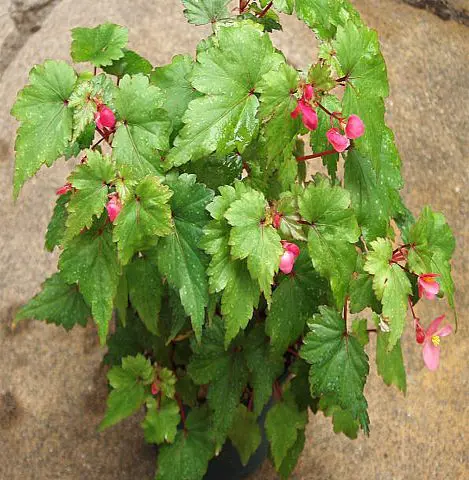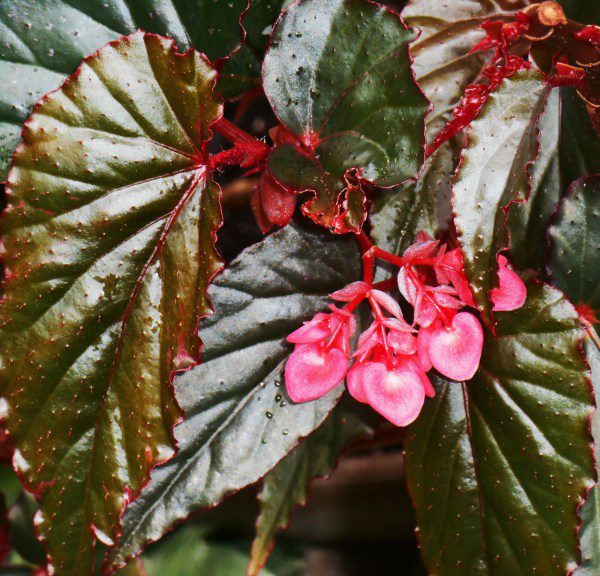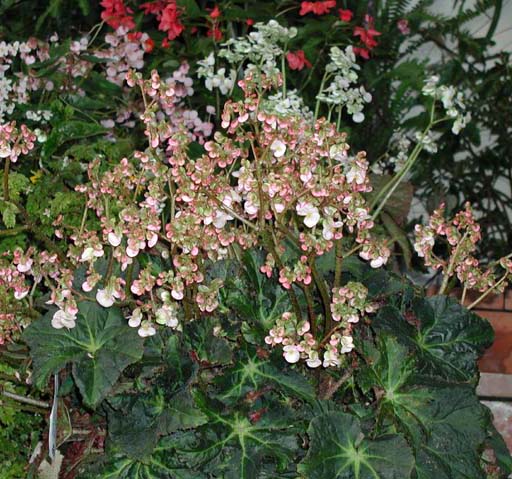by Brad Thompson
Do I have a goal in mind when I make a cross between two begonias? The answer is yes. Is that goal always the same? The answer is no. There are, however, two basic goals I have in mind in all crosses I do. One is to create something different and the second is to improve on something already done.
What hasn’t been done? There are many traits in begonias that are still waiting to be developed or developed more, such as a yellow color in a semperflorens, a palmate leaf in a cane, a double flower in a cane or a rhizomatous, an orange color in a superba, etc. Those traits are drastic changes and may take years to develop. Although I work towards creating such drastically new types of begonias, usually my goals are more subtle, such as more silver spots, compact growth, or mildew resistance.
An example is my cross of B. ‘Jumbo Jet’ with B. dregei ‘Glasgow’. B. ‘Jumbo Jet’ has many good qualities: ease of culture, mildew resistance, very large flowers, and nicely cut leaves. “Faults” that it has are typical of many superba canes: winter leaf drop, bare bottom growth, sparser growth, and a tendency to grow tall. My reasoning was that if I crossed such a cane with B. dregei I could solve the faults in both parents and create a hybrid with the best of both. I chose a cane that isn’t mildew prone to overcome the mildew prone problem of B. dregei. The rests of that cross were exactly as expected (this doesn’t always happen, of course). The canes that resulted such as B. ‘Black Gold’, were compact growing, full growing, didn’t drop leaves in winter, but still retained the large flowers, ease of culture and mildew resistance of B. ‘Jumbo Jet’. A side note: I chose to use B. dregei ‘Glasgow’ because it is the only dregei variety that doesn’t lose its silver spotting on its leaves. As a general rule, crosses to make improvements are much more successful than crosses to create something highly unusual.
My second goal of creating something drastically new and different is more challenging. One obstacle to this goal is the fact that even if the cross is successful, I still have to be able to grow the resulting begonias to maturity. Unusual crosses are usually harder to grow than more “normal” crosses. I can’t tell you how many times I have crossed a cane with B. ‘Charles Jaros’ and not been able to keep the results alive more than a season or two. The seedlings were exactly what I was trying for, canes with B. ‘Charles Jaros’ type leaves, but difficult to grow outside a terrarium. The same goes for that elusive yellow superba cane. There are only a handful of yellow begonias to work with and all are terrarium plants, except for B. pearcei, which is tuberous. B. pearcei is the most likely choice to use since it is the easiest to grow and the best yellow. Canes cross easily with B. pearcei and the seed sprouts easily, but growing the seedlings has eluded me so far. They just refuse to grow, though I haven’t given up. My new attack is to first try for a yellow shrub and then use that to create the yellow cane. I’ll let you know; the seed is planted. As you can see, creating something highly unusual isn’t always easy or it would have been done already, but don’t give up.
B. ‘Chivalry’ bred by Brad Thompson (B. ’Bokit’ x B. carrieae) × B. ‘Frilly Dilly’) | Photo: Julie Vanderwilt
The goal in hybridizing should always be to create something better, either easier to grow and maintain or something so unusual everyone will have to grow it no matter how difficult it is to grow.




